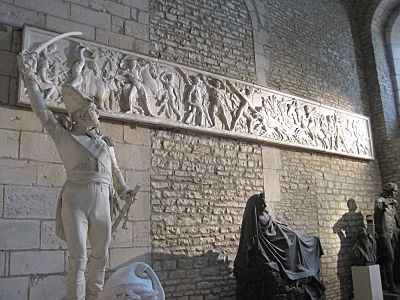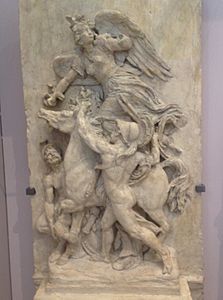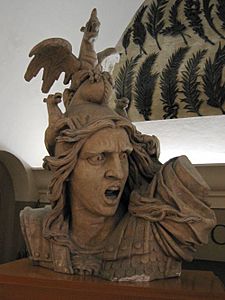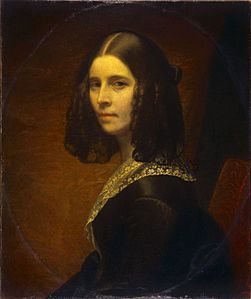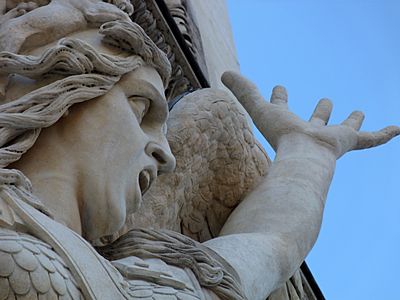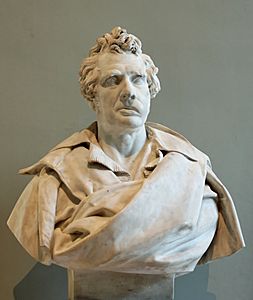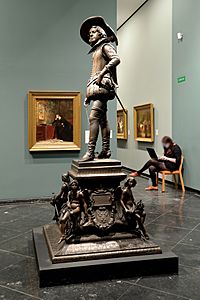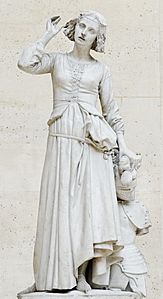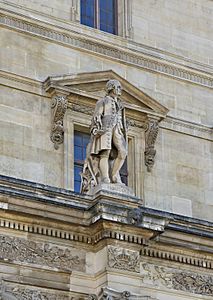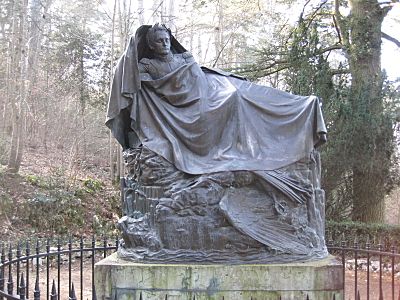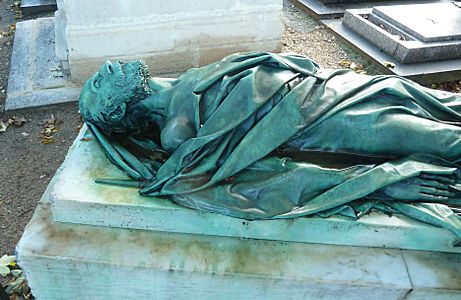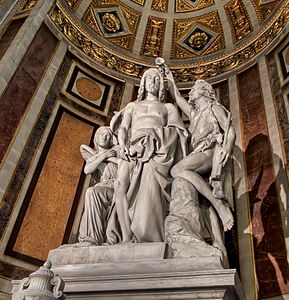François Rude facts for kids
Quick facts for kids
François Rude
|
|
|---|---|
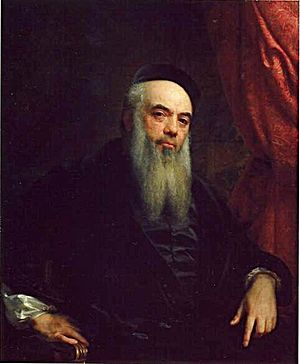
Portrait by Sophie Rude (1842)
|
|
| Born | 4 January 1784 Dijon, France
|
| Died | 3 November 1855 (aged 71) Paris, France
|
| Nationality | French |
| Known for | Sculpture, drawing |
| Awards | Légion d'Honneur |
François Rude (born January 4, 1784 – died November 3, 1855) was a famous French sculptor. He is best known for his amazing sculpture called Departure of the Volunteers. This artwork is also known as La Marseillaise and can be seen on the Arc de Triomphe in Paris. Rude's art often showed strong feelings about his country. His style also helped change art from the calm Neoclassical style to the more emotional Romantic style.
Contents
Early Life and Training
François Rude was born in Dijon, France, on January 4, 1784. His father was a blacksmith, and he taught young François how to work with iron. This was so François could take over the family business one day.
But François had other plans! At age 15, in 1799, he started taking art classes. He studied at the School of Fine Arts in Dijon. His teacher, Louis Fremiet, taught him drawing and sculpture. Fremiet helped Rude avoid joining Napoleon's army. In 1808, Fremiet sent Rude to Paris to continue his art studies.
In Paris, Rude joined the Imperial Ecole des Beaux-Arts. He studied under a classical sculptor named Pierre Cartellier. Rude also gained experience by helping another artist, Edme Gaulle. They worked on a large sculpture for the column in Place Vendôme. This column celebrated Napoleon's victories.
In 1809, Rude won second place in a big art competition. In 1812, he won two more awards. One of these was the Grand Prize, called the Prix de Rome. This prize usually meant he could study art in Rome, Italy. However, the art academy in Rome had money problems. Rude's trip was delayed. Then, Napoleon returned from exile, and war started again. After Napoleon's final defeat, Rude decided to leave France. He moved to Brussels, taking care of his teacher's family, including Sophie, who later became his wife.
Living in Brussels
François Rude lived in Brussels from 1817 to 1826. Many other French artists who disagreed with the new French government also lived there. One famous artist was the painter Jacques-Louis David. Rude's wife, Sophie, became David's student.
In Brussels, Rude got his first big art job. He was asked to create sculptures for the Belgian crown prince's hunting lodge. He made a large sculpture showing a classical hunting scene. He also created eight reliefs (sculptures that stick out from a flat surface) about the life of Achilles. Rude used classical styles but made his figures look very natural and full of movement. Sadly, the original sculptures were destroyed in a fire in 1879. But plaster copies still exist today.
Return to Paris and New Styles
Brussels did not offer enough exciting projects for Rude. So, in 1827, he moved back to Paris with Sophie. He showed a sculpture called Mercury fastening his sandals after slaying Argus at the Paris Salon. This artwork showed his changing style. It was a classical subject but had amazing energy and realism.
Rude settled in Paris in 1828. The French government became one of his main clients. They hired him to work on the Arc de Triomphe. In 1833, he showed a new work, A young Neapolitan fisherman playing with tortoise. This sculpture mixed classical ideas with romantic feelings. It showed strong emotion and won him an award, the Legion of Honor.
-
Bust of La Pérouse, 1828
The Arc de Triomphe: Departure of the Volunteers
The Arc de Triomphe was started in 1806 by Napoleon to celebrate his victories. Work stopped for many years after Napoleon was defeated. Later, a new French government decided to finish it.
Rude's work at the 1833 Salon caught the eye of Adolphe Thiers, a government minister. Thiers hired Rude to create a special sculpture for the Arc de Triomphe. This sculpture would show French volunteers leaving Paris in 1792 to fight against armies that opposed the French Revolution.
The sculpture, called Départ des volontaires de 1792 (Departure of the Volunteers of 1792), was finished in 1836. It is also known as La Marseillaise. This became Rude's most famous work. It shows a French revolutionary army marching off to battle. Rude's wife, Sophie, posed for the main figure. This figure is called the Génie de la Guerre (Genius of War). She is a woman with a sword, shouting to encourage the soldiers. The sculpture was instantly famous for its energy and spirit.
Patriotic and Historical Sculptures
After the success of the Arc de Triomphe sculpture, Rude received many more jobs. King Louis-Philippe wanted monuments that would make French people feel proud. In 1836, Rude was asked to create a statue of Maurice de Saxe, a French military hero. This statue showed him in a powerful pose.
Rude also created a silver statue of the young Louis XIII in 1843. In 1845, he finished a statue of Joan of Arc. She is shown with her hand raised, listening to the voices that called her to fight for France.
After the king was exiled in 1848, a new government came to power. They asked Rude to make a heroic statue of Michel Ney. Ney was a famous general under Napoleon. Rude created a version showing Ney with his sword raised, shouting at his soldiers. This statue was finished in 1853 and stands in Paris today.
Another important work was the tomb of Éléonore-Louis Godefroi Cavaignac. He was a leader who opposed the monarchy. Rude designed a tomb that looked like those for kings from the Middle Ages. The figure of Cavaignac looked very real, showing his body under a simple sheet.
One unique patriotic sculpture was Napoleon Awakening to Immortality (1845). This statue was made for a former captain in Napoleon's army. It shows Napoleon, wearing a laurel crown, under a military cloak. An eagle, Napoleon's symbol, is chained to the stone but is crying out to wake him. The chains that held Napoleon are broken. For many years, old soldiers who fought with Napoleon visited this statue to honor him.
-
Statue of the sculptor Jean-Antoine Houdon, 1847, facade of the Denon wing of the Louvre
-
Statue of Maréchal Michel Ney, 1853
Later Works and Death
Later in his life, Rude created several religious sculptures. These included a large bronze sculpture for the altar of St Vincent de Paul church in Paris (1852). He also made a mythological work called Hebe and the Eagle of Jupiter (1852). Other late works were Love Triumphant (1855–57) and Head of Christ (1852). Rude died before finishing some of these. His student and nephew, Paul Cabet, completed them.
Rude received a medal for his life's work at the Paris International Exposition in 1855. He passed away shortly after, on November 3, 1855, in Paris. He was buried at Montparnasse Cemetery in Paris.
His major religious works include a Baptism of Christ in the Church of the Madeleine. A smaller bust of Christ on the Cross was finished just before his death. The statue Love, dominator of the world was one of his last pieces. It was finished by Paul Cabet after Rude's death.
The Dijon Museum of Fine Arts, the Musée d'Orsay, and the Louvre have important collections of his sculptures.
-
The pulpit of the Church of St. Etienne, Lille
Rude's Students
François Rude taught many students who became famous artists themselves. One student, Charles-Auguste Lebourg, is known for creating the Wallace fountains in Paris. Another important student was Jean-Baptiste Carpeaux. Carpeaux later made his own version of a "Neapolitan Fisher Boy," which was a popular subject for artists at that time.
Musée Rude
The Musée Rude is a museum in Dijon, France. It opened in 1947 and is dedicated to François Rude's work. The museum displays plaster copies of his sculptures. It is located inside the old 11th-century church of Saint-Etienne.
See also
 In Spanish: François Rude para niños
In Spanish: François Rude para niños


